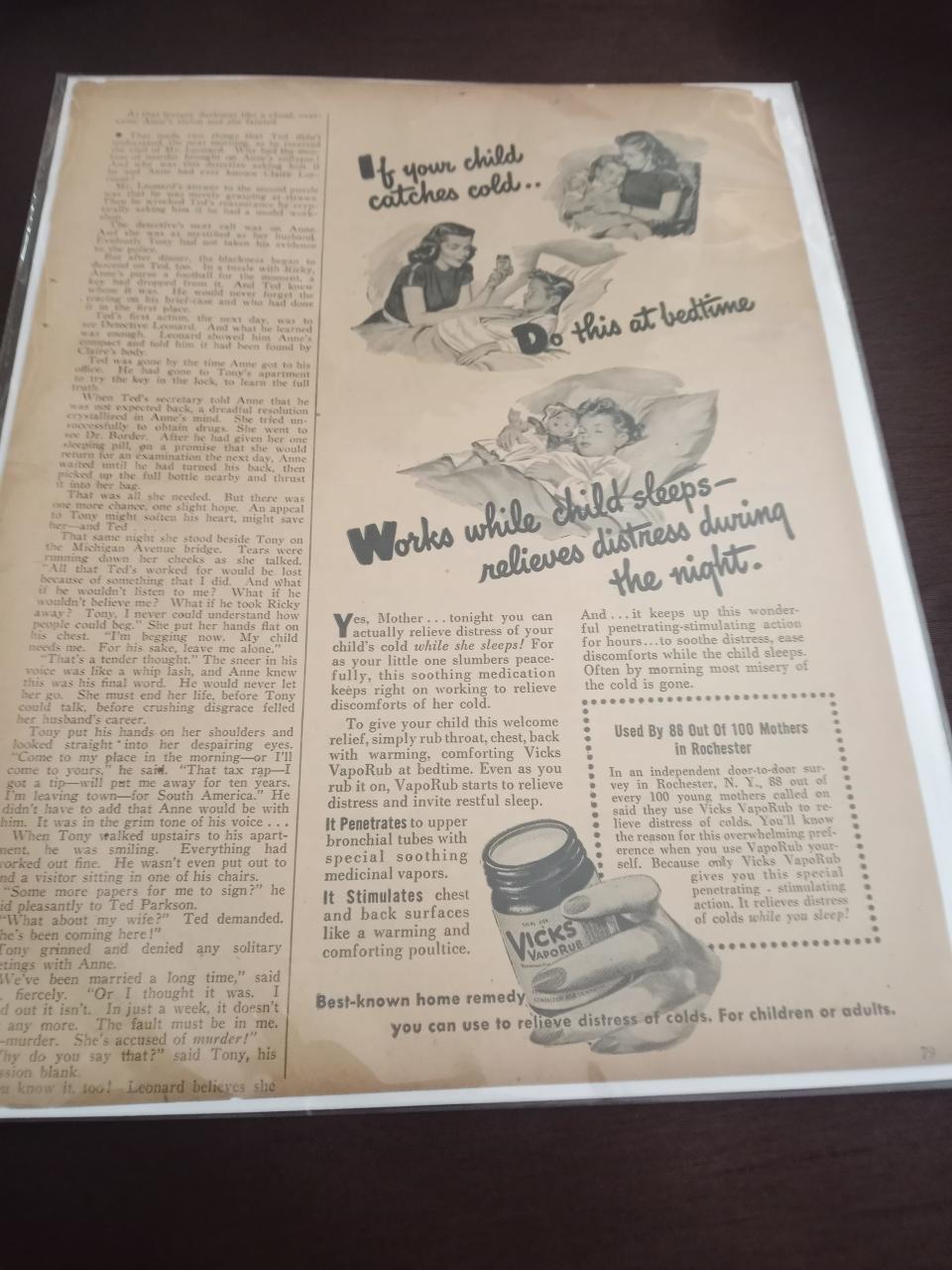BACK IN THE DAY: Moms got the job done with Vicks salve and boiled-onion poultices
In an era of children’s cold-medicine shortages, it is interesting to recall the old days. Before miracle drugs and tastier fruit-flavored medications, mountain folks relied on home remedies. Those of us who grew up in the 1940s have vivid memories of childhood colds being treated with Vicks salve. Properly called Vicks VapoRub, it came in a little blue jar and was the Number One treatment for head and chest colds, sore throat, and the flu. The trusted salve was rubbed on the chest and poked up the nose so often that the smallest country child was familiar with the menthol scent of Vicks.

Back then, children were only taken to the doctor in the most serious situations. Mothers depended on the almost magical relief found in the colorful cobalt-blue container, and generations of croupy children benefitted from this North Carolina invention. One story from the late 1800s declares that Pharmacist Lunsford Richardson developed it in desperation when three of his own children were sick at the same time.
Whatever the circumstances, he had a winning combination when he mixed Camphor, Eucalyptus Oil, and Menthol together as active ingredients. To stabilize the salve and mitigate some of the stronger odors, he added Cedarleaf Oil from cedar trees, Turpentine Oil from pines, Petroleum jelly, Thymol (from the herb Thyme) and Nutmeg Oil. In modern times when we are accustomed to long lists of manmade chemicals in products, we can appreciate the simplicity of his natural components.
One might wonder why he didn’t market such a popular cold remedy under his own name. He tried, but his long name wouldn’t fit on the small jar, especially when he considered calling it Richardson’s Croup and Pneumonia Cure Salve. Since his brother-in-law, Dr. Joshua Vick, helped launch his pharmaceutical career, one story indicates that Mr. Richardson honored the doctor by naming the salve Vicks. By 1911, the medicinal product became known as Vicks VapoRub, as it is today.
Of the many patents the creative druggist obtained, this salve quickly became the most popular. So, he focused on marketing it rather than his other concoctions. Some of those included Vicks Little Liver Pills, Vicks Chill Tonic, and Vicks Turtle Oil Ointment. Mountain children can be glad these remedies never gained popularity, or we might have been treated with them, as well.
Mr. Richardson’s sons eventually worked for the family business and developed advertising campaigns for the already well-known salve. Vintage magazine ads admonished readers: “Never go to bed with a cold…without Vicks VapoRub.” Pictures (with jars of Vicks) featured worried mothers standing watch at bedsides. Reassuring captions promised: “Works while (the) child sleeps and relieves distress during the night.”
The 1918 Spanish flu pandemic sent sales even higher. Operating 24 hours a day, the Greensboro company began producing a million jars of Vicks salve every week. Traveling representatives were reassigned to headquarters to help with manufacturing because sales almost tripled throughout the deadly epidemic. Since few medical options were available for the flu, the diligent Vicks company is credited with helping to save lives.
Most children of my generation didn’t mind Vicks salve treatments for colds and stuffy noses. I remember the menthol warmth helping me to breathe better. But one home remedy I dreaded was boiled-onion poultices. To make them, Mama simmered a large pot of peeled onions with just enough water to create a thick lumpy mixture. Then, she ladled the boiling onions into a red-and-white-striped flour sack, tied the top with twine, and plopped the steaming poultice onto my throat and chest. Much screaming and yelling ensued!
According to her, extreme heat would help the natural onion juice to penetrate my skin and keep the chest cold from turning into deadly Pneumonia. At that point, deadly Pneumonia didn’t seem like such a bad option in my mind. Over seventy years later, I still remember the redness of my skin. But aggressive home treatments to prevent the feared ‘Newmony Fever’ must have worked — I’m still alive.
Somehow, I realized country people were doing the best they could without the availability of ‘doctor medicine.’ Times were tough back then, and mountain folks used what they had on the farm to improvise home remedies. The notion that boiling-hot poultices imparted medicinal benefits had been around for centuries, and it certainly survived into my Appalachian childhood.
Onions were believed to help purify the body, so cooking them for poultices seemed to be the logical next step. Other farm products were traditionally used, as well, including potatoes and cabbages. Various weeds, wildflowers, roots, twigs, and bark were made into rubs, poultices, or honey-flavored teas. Some of these included dandelion leaves, goldenseal, yellow root, comfrey, wild cherry, plantain, elderberry, sassafras, Spicewood, burdock root, and even goldenrod. In previous generations other natural plants, including violet and yarrow, were also used. To prepare curative poultices, old-timers sometimes boiled clay, vinegar, Epsom Salts, or baking soda with herbs. When it was available, garlic was also a favorite. In retrospect, maybe a pot of simmering onions wasn’t the worst choice for a homemade poultice.
Vintage advertisements claimed Vicks VapoRub acted much like a poultice to penetrate skin with warmth and relief from congestion. They were implying that Vicks could be used instead of, or in addition to, traditional boiled-vegetable-herb poultices. Medicine was gradually changing in those early years of the 20th century, and Vicks became a forerunner in the new trend of remedies manufactured outside the home.
Traditionally, farmers purchased very few items at the country store since they usually lacked cash money. They grew most of their food and supplemented their diet by hunting rabbits and squirrels in the forests. Great-grandparents’ experience in foraging herbs enabled families to rely on home remedies for generations of little kids. This reality was an unlikely background for the sudden popularity of a store-bought cold remedy like Vicks VapoRub.
However, the relatively inexpensive — and highly effective — Vicks quickly became a part of farm families’ arsenal to fight wintertime ailments. The blue jars came in various sizes, beginning at only 30¢, during the 1918 flu pandemic. If mountain folks hadn’t already realized the advantages of Vicks, they certainly became devotees during that scary time. With reports of deaths all around them, country families were grateful for the soothing qualities of menthol-scented salve. Thereafter, several generations of mountain children were successfully ‘doctored’ at home with the trusted Vicks treatment. Over time, folks also came to depend on the familiar ointment to treat toenail funguses, sore muscles, migraine headaches, and myriad other ailments.
There have been stories of older adults returning to their childhood home to settle the estate of a departed relative. In the process of finalizing the house to be sold, they discovered new, unopened jars of Vicks VapoRub stored on shelves and in bureau drawers. Curious if it might be rancid, but having nostalgic recollections of Vicks salve, they applied some to their skin. Surprisingly, the natural ingredients didn’t seem to have dissipated or spoiled over the years. A whiff of that strong menthol was still unmistakable. Obviously, using outdated products wouldn’t be recommended. But the momentary feeling of returning to childhood was meaningful and comforting during the difficult experience of closing the family home.
Think about your childhood memories of little blue jars of Vicks VapoRub. Hopefully, you weren’t also subjected to boiled-onion poultices for chest colds, but you may recall other common remedies back then. Thankfully, times have changed. Even during the current nationwide shortage of children’s cold medicines, modern kids won’t have recollections of flour sacks filled with steaming onions. Still, some parents may reach for the trusted remedy of old-timey Vicks salve.
Janie Mae Jones McKinley's new book, "The Legacy of Bear Mountain, Volume 2," (340 pages) is available in Hendersonville at the Historic Court House Gift Shop, The Curb Market, Henderson County Genealogical & Historical Society, M. A. Pace General Store (Saluda) and at Amazon.com. Over three years of her Back in the Day newspaper columns are included, along with new stories of Granny’s life on Bear Mountain

This article originally appeared on Hendersonville Times-News: Vicks VapoRub-home remedies

